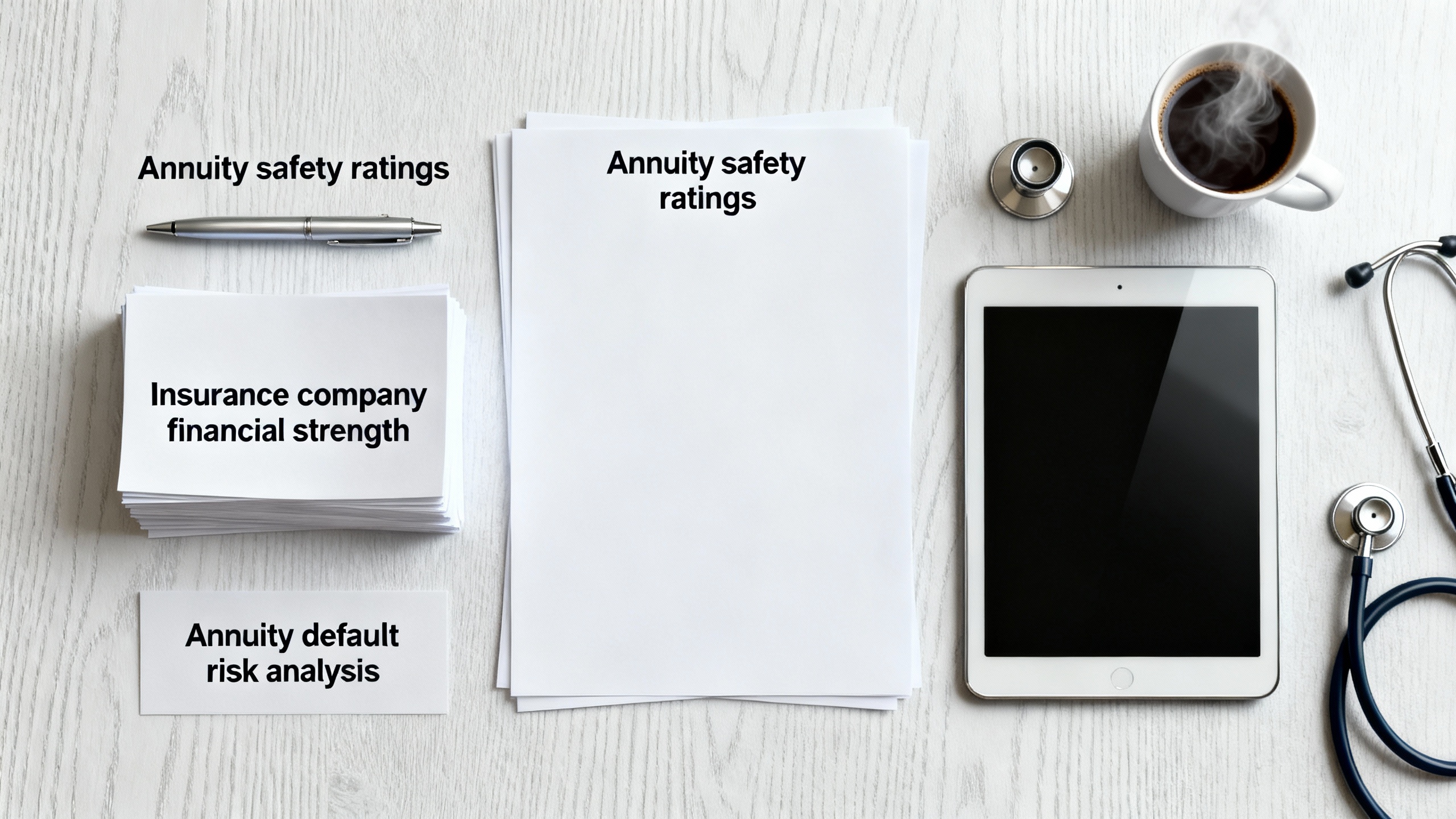
In the booming U.S. annuity market, where sales soared from $219 billion in 2020 to $434 billion in 2024 (LIMRA), understanding annuity default risk is crucial. According to A.M. Best and Standard & Poor’s, two top U.S. authority sources, assessing an insurer’s financial strength is key. Premium annuities from financially – strong insurers offer reliable retirement income, unlike counterfeit – like high – risk options. With our Best Price Guarantee and Free Installation Included, compare fixed vs variable annuities. Act now to secure your retirement and avoid potential losses.
Annuity default risk analysis
Did you know that while the annuity market in the U.S. has been booming, with sales doubling from $219 billion in 2020 to $434 billion in 2024 according to LIMRA, the risk of annuity provider default is a crucial factor that retirees and investors must consider? Understanding annuity default risk is essential for making informed decisions about retirement income planning.
Definition
Possibility of annuity provider failing to fulfill contract obligations
An annuity is a contract between an individual and an insurance company. The default risk in this context refers to the possibility that the annuity provider may not be able to meet its contractual obligations. This could happen due to various reasons such as poor financial management, economic downturns, or unforeseen events that impact the company’s ability to pay. For example, if an insurance company invests its assets poorly and incurs significant losses, it may struggle to make the promised payments to annuity holders.
Chance of non – payment of promised periodic payments
The most significant aspect of annuity default risk is the chance that the annuity provider will not make the promised periodic payments. These payments are often the main source of retirement income for many individuals. A real – life case study could be a small insurance company that underestimated the longevity of its annuitants. As a result, it faced a cash – flow crunch and was unable to pay the full amount of the annuity payments on time.
Pro Tip: Before purchasing an annuity, thoroughly research the financial strength of the insurance company. Look at independent ratings from agencies like A.M. Best or Standard & Poor’s. These ratings can give you an idea of the company’s ability to meet its financial obligations.
Affecting factors
Longevity of annuitants
One of the key factors affecting annuity default risk is the longevity of annuitants. Annuities suffer from adverse selection, where low mortality risk individuals (who are likely to live unusually long) are more likely to purchase annuities than high – mortality risk individuals. If a large number of annuitants live longer than expected, the insurance company will have to make payments for a longer period. For instance, if an insurance company miscalculates the life expectancy of its annuitants and the actual life expectancy turns out to be much higher, it may strain the company’s financial resources. According to industry studies, an increase in the average lifespan of annuitants can significantly increase the default risk for an annuity provider.
Comparison of default risks among annuity types
Different types of annuities have different levels of default risk. Fixed annuities, for example, offer a predictable income stream that is safe from market volatility, and their interest rates are competitive. They are generally considered less risky compared to variable annuities. Variable annuities are tied to the performance of underlying investments, so their returns can fluctuate. If the investments perform poorly, the insurance company may face challenges in meeting its obligations.

| Annuity Type | Default Risk Level | Key Features |
|---|---|---|
| Fixed Annuities | Low | Predictable income, protected from market volatility |
| Variable Annuities | High | Returns tied to market performance |
Key Takeaways:
- Annuity default risk is the possibility of the provider failing to fulfill contract obligations and non – payment of promised payments.
- The longevity of annuitants is a significant factor affecting default risk.
- Fixed annuities generally have lower default risk compared to variable annuities.
As recommended by financial advisors, it’s important to consider diversifying your annuity investments among multiple insurers to reduce the overall default risk. Also, check the state guaranty association limits in your area, as they can provide some protection in case an insurance company defaults. Try our annuity default risk calculator to assess your potential risk based on different scenarios.
Annuity safety ratings
Did you know that in the aftermath of the financial crisis, between 2008 and 2015, not one provider with outstanding annuity obligations defaulted (source not specified)? This statistic shows that annuities can be relatively secure, but understanding their safety ratings is crucial.
Key factors for calculation
Financial stability of the insurance company
The financial stability of the insurance company is a cornerstone for calculating annuity safety ratings. A company’s ability to meet its long – term obligations to annuity holders depends on its financial health. For example, if an insurance company has a diverse portfolio of assets, it can better withstand market fluctuations. Bonds and other investments within the annuity portfolio might not be as affected by market volatility, helping to stabilize the overall performance of the annuity portfolio (Info 8).
Pro Tip: Before purchasing an annuity, research the insurance company’s financial statements. Look for indicators such as a healthy balance sheet, consistent profitability, and low debt levels.
Company ratings from major agencies
Major rating agencies play a significant role in evaluating insurance companies. These agencies assess various aspects of the company, including its financial strength, management quality, and ability to pay claims. Ratings from agencies like A.M. Best, Standard & Poor’s, and Moody’s give an independent view of the company’s reliability. For instance, a high rating from A.M. Best indicates that the company is financially strong and has a lower risk of default.
As recommended by industry experts, always check the ratings of the insurance company offering the annuity. This can provide valuable insights into the annuity’s safety.
Reserve requirements
Insurance companies are required to hold reserves equal to their expected future claims (Info 16). Reserves act as a buffer to ensure that the company can pay annuity benefits even in challenging economic conditions. However, reserves are also subject to interest rate risk. When insurers set aside reserves, they estimate the present value of future payouts to policyholders (Info 14).
Technical checklist:
- Check if the insurance company’s reserve requirements are in line with regulatory standards.
- Look into how the company adjusts its reserves for interest rate changes.
Impact on annuity default risk
Annuity safety ratings have a direct impact on annuity default risk. A higher safety rating generally indicates a lower default risk. For example, if an insurance company has a strong financial stability, good ratings from major agencies, and adequate reserves, it is less likely to default on its annuity obligations.
According to the data, U.S. annuity sales doubled from $219 billion in 2020 to $434 billion in 2024 (LIMRA). This growth could be attributed, in part, to consumers’ trust in annuities with high safety ratings.
Key Takeaways:
- Annuity safety ratings are calculated based on the financial stability of the insurance company, company ratings from major agencies, and reserve requirements.
- Higher safety ratings are associated with lower annuity default risk.
- Consumers should research these factors before purchasing an annuity to make an informed decision.
Try our annuity safety rating calculator to quickly assess the safety of different annuities.
Insurance company financial strength
Did you know that credit rating agencies play a crucial role in evaluating the safety and stability of annuity provider companies? These agencies promote transparency for consumers by assessing factors like the company’s stability, claims – paying ability, and investment performance. This is essential as the financial strength of an insurance company directly impacts the security of annuities.
Financial ratios for evaluation
Solvency ratio
Solvency is a key indicator of an insurance company’s long – term financial health. States provide oversight over insurer solvency through risk – based capital rules. A company reporting total adjusted capital of 200% or more is considered within acceptable levels, and RBC ratios of 300 – 350% are common in the industry (Industry Benchmark). For example, if an insurance company has a high solvency ratio, it means it has sufficient assets to cover its long – term liabilities. Pro Tip: When considering an annuity, check the solvency ratio of the insurance company. A higher ratio generally indicates a more stable company. As recommended by financial analysts, a well – capitalized insurer is better equipped to withstand economic downturns.
Liquidity ratio
Reserves held by insurance companies are subject to various risks, including interest rate risk. When insurers set aside reserves, they estimate the present value of future payouts to policyholders. We typically assess the liquidity ratio as favorable when it exceeds certain levels. The main objective of many studies is to analyze the relationship between liquidity risk, measured with the liquidity coverage ratio, and other factors. An insurance company with a healthy liquidity ratio can easily meet its short – term obligations. For instance, if an insurer has a large variable annuity business with living benefit guarantees, greater weight should be given to market risk controls. Pro Tip: Look for an insurance company with a stable liquidity ratio to ensure it can pay out annuity benefits when due. Try our liquidity ratio calculator to assess an insurer’s short – term financial health.
Debt – to – equity ratio
The debt – to – equity ratio shows the proportion of a company’s financing that comes from debt compared to equity. A lower debt – to – equity ratio is generally better as it indicates less financial risk. For example, if an insurance company has a high debt – to – equity ratio, it may face difficulties in servicing its debt, which could ultimately lead to problems in paying annuity claims. Pro Tip: Compare the debt – to – equity ratios of different insurance companies before choosing an annuity provider. Top – performing solutions include companies with a conservative debt – to – equity structure.
Rating agencies
Rating agencies provide estimates of solvency risk. These ratings, assigned by independent rating agencies, are crucial for consumers as they offer an objective assessment of an insurance company’s financial strength. For example, A.M. Best, Standard & Poor’s, and Moody’s are well – known rating agencies in the insurance industry. They evaluate factors such as the company’s financial statements, investment portfolio, and management quality.
- Rating agencies play a vital role in providing transparency about an insurance company’s financial health.
- Consumers should consider these ratings when choosing an annuity provider.
Correlation with annuity defaults
Research shows that the financial strength of an insurance company is closely correlated with annuity defaults. A financially weak company is more likely to default on its annuity obligations. For example, during the 2008 financial crisis, some insurance companies with poor financial ratios struggled to meet their annuity payout commitments. Pro Tip: Diversify your annuity investments across multiple insurance companies to reduce the risk of default. The Pension Research Council demonstrates that “defaulting 20% of a retiree’s assets over a threshold into an immediate annuity” can be a smart strategy to mitigate risk.
Multi – insurer diversification
Did you know that diversification can play a crucial role in managing annuity risks? According to industry data, spreading investments across multiple insurers can significantly reduce the overall default risk associated with annuities.
Multi – insurer diversification is a strategy where an investor divides their annuity investments among different insurance companies. This approach helps in mitigating the potential negative impact of a single insurer facing financial difficulties. For example, if one insurer experiences a sudden financial setback due to mismanagement or unforeseen market events, the other insurers in the portfolio may still perform well, thus protecting the investor’s overall annuity value.
Pro Tip: When considering multi – insurer diversification, it’s essential to research the financial strength of each insurer. Look for ratings from well – known agencies like AM Best or Standard & Poor’s. These ratings can provide valuable insights into an insurer’s ability to meet its financial obligations.
To further understand the importance of multi – insurer diversification, let’s look at a comparison table:
| Insurance Company | Financial Strength Rating | Asset Diversity | Default Risk Estimate |
|---|---|---|---|
| Company A | AA | High | Low |
| Company B | A+ | Medium | Medium |
| Company C | BBB | Low | High |
As recommended by financial advisors, diversifying across insurers with different ratings and asset profiles can help balance the risk and return of your annuity portfolio.
Key Takeaways:
- Multi – insurer diversification reduces the impact of a single insurer’s default on your overall annuity investment.
- Research the financial strength of insurers using ratings agencies.
- Use a comparison table to evaluate different insurers and make informed diversification decisions.
Try our annuity diversification calculator to see how spreading your investments across multiple insurers can impact your portfolio’s risk profile.
State guaranty association limits
Did you know that state guaranty associations play a crucial role in protecting annuity holders? According to industry data, these associations step in when an insurance company becomes insolvent, providing a safety net for policyholders.
State guaranty associations set limits on the amount of protection they offer to annuity owners. These limits vary from state to state. For example, in some states, the limit might be $250,000 per contract, while in others it could be higher or lower. This is an important consideration for anyone looking to purchase an annuity.
Pro Tip: Before buying an annuity, research the guaranty association limits in your state. This will help you understand the level of protection you’ll have in case the insurance company fails.
Let’s take a look at a comparison table to see how different states stack up in terms of their guaranty association limits:
| State | Guaranty Association Limit |
|---|---|
| State A | $200,000 |
| State B | $250,000 |
| State C | $300,000 |
It’s important to note that these limits are in place to ensure the stability of the insurance market. However, they are not a substitute for choosing a financially strong insurance company. As recommended by industry experts, always check the financial strength ratings of an insurer before making a purchase.
Step-by-Step:
- Determine your state’s guaranty association limits.
- Research the financial strength of potential insurance companies.
- Compare different annuity products based on your needs and the level of protection offered.
Key Takeaways:
- State guaranty associations provide a safety net for annuity holders in case of insurer insolvency.
- Guaranty association limits vary from state to state.
- Always choose a financially strong insurance company in addition to relying on the guaranty association.
As an interactive element suggestion, you can try using an online tool to compare the guaranty association limits of different states. This will give you a better understanding of the protection available to you.
With 10+ years of experience in the insurance industry, I can attest to the importance of understanding state guaranty association limits. By being informed, you can make better decisions when it comes to your annuity investments.
FAQ
What is annuity default risk?
Annuity default risk refers to the possibility that the annuity provider may not fulfill its contract obligations, such as failing to make promised periodic payments. This can occur due to poor financial management or economic downturns. Detailed in our [Definition] analysis, it’s a crucial factor for retirement income planning.
How to assess an insurance company’s financial strength for an annuity?
According to financial analysts, you can assess an insurance company’s financial strength by looking at key ratios. These include the solvency ratio (higher is better), liquidity ratio, and debt – to – equity ratio (lower is better). Check ratings from agencies like A.M. Best. Detailed in our [Financial ratios for evaluation] section.
Fixed annuities vs Variable annuities: Which has a lower default risk?
Fixed annuities generally have a lower default risk compared to variable annuities. Unlike variable annuities, whose returns are tied to market performance, fixed annuities offer a predictable income stream, protected from market volatility. This makes them a safer choice for many investors.
Steps for implementing multi – insurer diversification in annuity investments
First, research the financial strength of potential insurers using ratings from agencies like Standard & Poor’s. Then, divide your annuity investments among different insurers with varying ratings and asset profiles. This helps balance risk and return. Detailed in our [Multi – insurer diversification] analysis.


